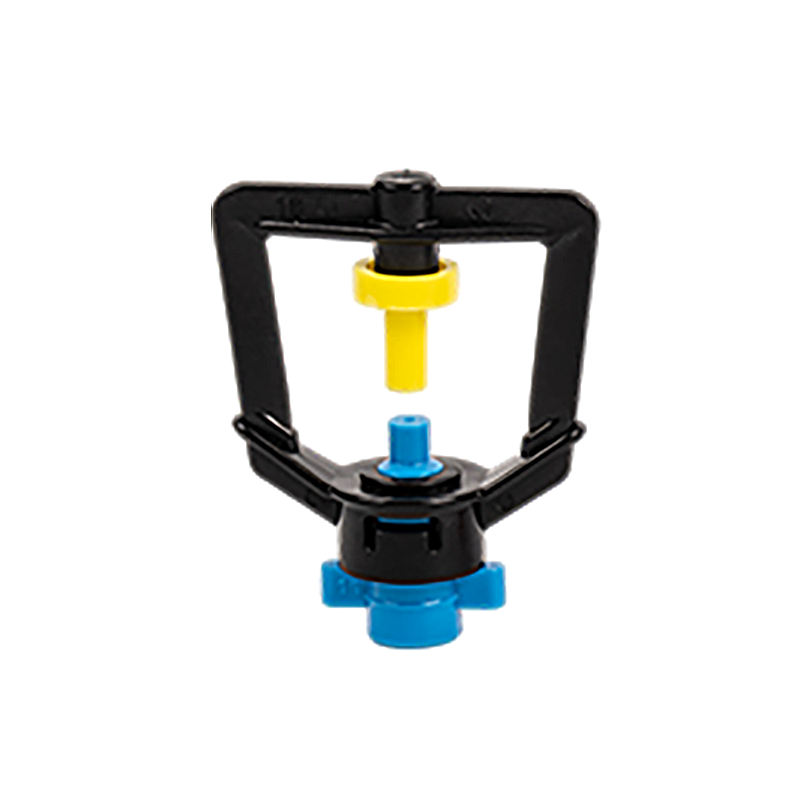The design of micro sprinklers plays a crucial role in determining water distribution uniformity. Here's how:
Nozzle Design: Within micro sprinkler systems, the nozzle design is an intricate science. Engineers meticulously select materials and shapes to control the trajectory, velocity, and size of water droplets. The choice of nozzle diameter is critical, as it directly impacts flow rate and distribution uniformity. The orifice shape influences the spray pattern, ensuring optimal coverage across the irrigated area. Nozzle angle plays a crucial role in determining the reach and dispersion of water, particularly in systems with varying terrain or plant heights.
Flow Rate and Pressure: Achieving precise control over flow rate and pressure is fundamental in micro sprinkler design. Engineers meticulously calibrate these parameters to match the specific requirements of the irrigation application. Pressure regulators are strategically integrated into the system to maintain consistent performance, compensating for fluctuations in water supply or changes in elevation. By fine-tuning flow rate and pressure, engineers ensure that each micro sprinkler delivers the intended volume of water with uniformity and efficiency.
Coverage Pattern: Micro sprinklers offer a diverse array of coverage patterns, each tailored to address unique irrigation needs. Design engineers analyze factors such as plant spacing, soil type, and water distribution requirements to select the optimal pattern for a given application. Full-circle patterns provide 360-degree coverage, ideal for open fields or orchards, while half-circle or quarter-circle patterns are suited for narrower areas or irregularly shaped plots. Engineers leverage advanced modeling techniques to simulate water distribution patterns and optimize coverage uniformity across the entire irrigated area.
Spacing and Layout: The spacing and layout of micro sprinklers are meticulously planned to ensure thorough coverage and efficient water distribution. Design engineers consider factors such as crop type, root depth, and soil moisture requirements when determining sprinkler spacing. Advanced algorithms are employed to optimize sprinkler layout, balancing coverage overlap with water conservation goals. By strategically positioning micro sprinklers, engineers maximize irrigation efficiency while minimizing water waste and runoff.
Droplet Size and Distribution: Micro sprinkler design intricately controls the size and distribution of water droplets emitted during irrigation. Engineers fine-tune nozzle configurations and operating parameters to produce droplets of uniform size and dispersion. The goal is to achieve maximum absorption and minimal evaporation, optimizing water use efficiency.
Wind Resistance: Wind can significantly impact the performance of micro sprinkler systems, causing drift and uneven water distribution. Engineers employ innovative design strategies to enhance wind resistance and maintain uniformity. Low-profile nozzles and aerodynamic components reduce wind drag, ensuring stable operation even in gusty conditions. Wind tunnel testing and real-world field trials validate the effectiveness of these design enhancements, ensuring reliable performance across diverse environmental settings.
Material and Construction: Micro sprinkler components are meticulously crafted from high-quality materials to withstand harsh environmental conditions and prolonged use. Engineers select corrosion-resistant metals, durable polymers, and UV-stabilized plastics to ensure long-term reliability. Rigorous testing protocols assess material strength, chemical compatibility, and resistance to degradation, guaranteeing robust performance in agricultural and landscaping applications. Modular construction facilitates easy installation, maintenance, and repair, minimizing downtime and optimizing system uptime.
YR9806 refraction nozzle for nurseries greenhouse net room
 By Admin
By Admin 